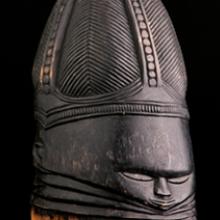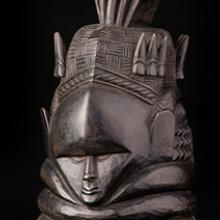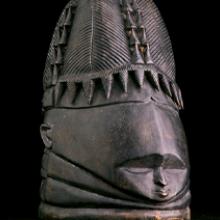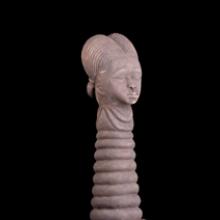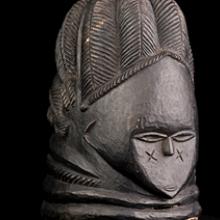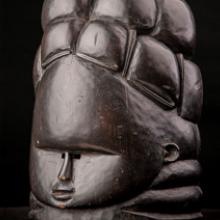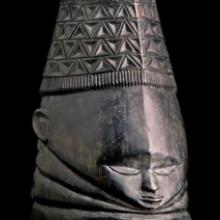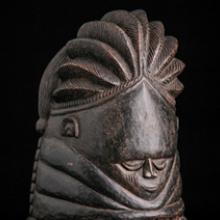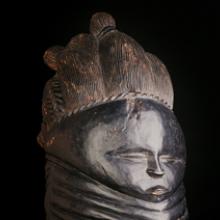International Terminal










Mask c. 1950–67
Gola
Liberia
gumwood, stain
Collection of the Phoebe A. Hearst Museum of Anthropology, University of California, Berkeley
5–6254
L2010.0401.012
Hair and the Sowei Mask
Few works of African sculpture are more focused on the depiction of hairstyles than are the sowei masks of the Sande women’s initiation society. The representation of hairstyles on masks from this region is among the most detailed and realistic in Africa. The hairstyle of the mask, a carefully carved representation of braided, plaited, knotted, and decorated strands of hair, takes up between one-third to one-half of the total height of the carving.
Hair is a preeminent symbol of feminine beauty among members of the Sande society. An attractive head of hair is one that is thick, lush, and abundant, like “the rice in a well-tended field.” Women spend hours styling each other’s hair, and the process also serves as an act of social bonding.
Ironically, women throughout this region commonly wear a head tie, which covers a carefully and beautifully coiffed hairstyle. The use of head ties may be due to Islamic influence; however, it is more of a social, rather than a religious convention. There are no restrictions against women showing their hair in public.
Mask c. 1940–57
Mende, Gola, or Vai
Liberia
gumwood, shoe polish
Collection of the Phoebe A. Hearst Museum of Anthropology, University of California, Berkeley
5–5834
L2010.0401.002
Stylistic Elements of the Sowei Mask
Masks are always carved from wood and follow certain stylistic parameters. An exemplar mask must be symmetrical and balanced with a full, ringed neck, complementing a small face with closed mouth and lowered eyes. The closed mouth suggests seriousness and silence, because speech and laughter are associated with the human sphere rather than the masked spirit world.
The mask must also have a large forehead, a delicate nose, a prominent, poised brow, and an elaborate hairstyle. The slightly downcast eyes are also associated with the nonhuman and mysterious essence of the spirit, which inhabits the mask. The eye slits (sometimes placed at the neck) are positioned to be as inconspicuous as possible. The mask’s large neck circumference allows the mask to be easily placed over the dancer’s head. Because the mask is made for dancing, it is necessary for it to be lightweight and rest easily on a person’s shoulders. The mask’s surface must be perfectly smooth, sanded to perfection, dyed a deep, black shade, and polished to a lustrous shine.
This mask displays a pair of horns on either side as well as smaller rows of what are probably duiker horns, a type of medicine charm.
Mask c. 1950–67
Gola or Vai
Liberia
gumwood, stain
Collection of the Phoebe A. Hearst Museum of Anthropology, University of California, Berkeley
5–6255
L2010.0401.014
The Masked Performer
Fully costumed, high-ranking officials of the Sande society perform the dances of the masked spirit (ngafa among the Mende)—the embodiment of the mystical power of Sande. Each masquerader has an individual name and identity. Generic terms can also be used including zogbe (among the Gola), zooba (among the Vai), and sowei or ndoli jowei (among the Mende), the expert leader who dances. Each sowei masker must be a virtuoso, exhibiting exceptional talent and skill as a dancer. The term zo designates a person who has mastered an art form, and by doing so, has earned the admiration of the entire society.
A sowei frequently appears throughout the Sande initiation period. Maskers may also perform during ceremonies marking the death of an old chief or the crowning of a new one. In addition, they often participate in celebrations held in honor of an important guest to a village, following the death of an important ligba (official of the Sande society), or during the initiation of a new mask into the Sande society. A masker may also appear at holiday celebrations or other major social events. Less frequently, a sowei comes forth to prosecute an offender against Sande laws, such as a man who has spied on the Sande initiation rituals.
Mask c. 1950–67
Gola
Liberia
gumwood, stain
Collection of the Phoebe A. Hearst Museum of Anthropology, University of California, Berkeley
5–6252
L2010.0401.010
The Costume of the Gbetu Masker
The gbetu mask, worn by male members of the Poro society, is typically accompanied by a costume consisting of three skirts of raffia worn around the waist, chest, and neck. The ensemble resembles a haystack without arms or legs. The Gola are particularly fond of acrobatic performances; the term for such a person is anyun kwái dùlù—the magician or trickster. The gbetu performs with energetic and agile movements as it strides to and fro. It can rise to a considerable height and then suddenly collapse until it is nearly flush with the ground. Besides its ability to grow tall, the gbetu masker attempts daring feats, such as dancing with a lighted torch inside its dry raffia costume. Unlike most Poro masks, the gbetu is usually spoken of as feminine due to its ability to “give birth” to small dancing figures that emerge from beneath the raffia costume. Generally, these “children” wear only a raffia costume with no wooden head, but some scholars have recorded that the “children” also wear small wooden masks.
Mask c. 1940–57
Kpelle or Gola
Liberia
gumwood, shoe polish
Collection of the Phoebe A. Hearst Museum of Anthropology, University of California, Berkeley
5–5836
L2010.0401.003
Masks commonly display carved scarification on the cheeks, forehead, or outer corners of the eye area, which serve as supplemental ornamentation. Other common marks include tear or x-shaped marks on each cheek.
Mask-Making Materials and Techniques
Sowei masks are carved from lightwood species of trees such as the cotton tree. The black coloration for the Sande masks comes from indigenous plant sources including njekoi or njui. The leaves of these plants are boiled with water to make a liquid dye. The black raffia costume is treated with the same colorant. Njekoi leaves are gathered, ground in a mortar, and boiled with water for several days. When cooled, the preparation is applied to a newly carved mask, giving the light-colored wood a smooth, lustrous black sheen.
The substance also seems to act as a preservative and protective agent, since many plants contain ingredients that guard against insect damage. In older sowei masks, insect damage is sometimes found on the inner mask wall, but not on the treated, outer black surface.
In 1962, Kondeh Bundu, a Mende carver, discussed his materials and techniques:
“I use a sandpaper stick, native rough leaves (in Mende: ramami), to make it smooth. Then there is another plant known as jui, which I use to blacken it. It is a kind of herb or leaf, a herb from the bush.” He went on to note that he had begun to use commercially available black shoe polish as a way to “hasten his work” but preferred the native dye.
Donna Page, Surfaces, 2009.
Sowei masks are commissioned, kept, and maintained by the Sande leaders. The masks are reused in dance appearances over a number of years. To maintain their beauty, masks are oiled before each public appearance and recoated with black dye when necessary.
Mask before 1985
Mende or Gola
Liberia
gumwood, stain
Collection of the Phoebe A. Hearst Museum of Anthropology, University of California, Berkeley
5–15242
L2010.0401.024
A Gola Carver’s Mask “Comes to Life”
Warren L. d’Azevedo, an ethnographer who conducted extensive research among the Gola in the 1960s, collected many of the masks on display in this exhibition. D’Azevedo documented the sense of accomplishment felt by one Gola carver upon seeing his mask in a public performance:
It is not possible to see anything more wonderful in this world. His face is shining, he looks this way and that, and all the people wonder about this beautiful and terrible thing. To me, it is like what I see when I am dreaming. I say to myself, this is what my neme [spiritual guardian] has brought into my mind. I say, I have made this. How can I make such a thing? It is a fearful thing I can do. No other man can do it unless he has the right knowledge. No woman can do it. I feel that I have borne children.
“Mask Makers and Myth in Western Liberia,” Arts of Africa, Oceania, and the Americas, 1993.
Inspiration for a mask often comes to the carver from a dream presented by a neme. “The ‘dream’ that provides the inspiration for a specific work, is often referred to as the ‘gift’ of a loving neme and the completed work as the child of the union.”
Mask c. 1950–67
Gola or Vai
Liberia
gumwood, stain
Collection of the Phoebe A. Hearst Museum of Anthropology, University of California, Berkeley
5–6260
L2010.0401.019
Birds are common embellishments found on Sande masks. Noninga ta kulo lolo is a Mende saying that means “birds see far.” In Mende mythology, birds have the ability to see into the future and often act as intermediaries between the human and spirit realm.
Maintaining Silence and Secrecy
Members of the Sande society take great pains to ensure that the masker’s true identity stays hidden. For instance, “on occasions when the zooba [in Vai] is to perform, seven or eight women will enter the zoo house (where Sande masks and paraphernalia are kept), but only three or four exit, leaving some doubt as to which one is the dancer.” The Sande spirit must be completely covered by the mask, clothing, and raffia so that no part of her is visible to the audience while dancing or at rest. This would tarnish the masker’s embodiment of the ngafa or mystical spirit.
One of the defining characteristics of the sowei mask is its silence, for it neither speaks nor is spoken to directly by the audience to emphasize its spiritual, otherworldly being. It does not communicate with ordinary mortals, nor do masked performers appear to speak to one another when there is more than one dancing. If conversation does occur, it is from the masker’s attendant. Her attendant calls out the masker’s presence to introduce her to the crowd so that all are aware of her presence. The dancer may carry a cane or a twig to communicate with musicians or her attendant.
The gourd rattle is the traditional musical accompaniment to the masker’s performance, but today, male musicians may also play instruments such as drums or slit-gongs (hollowed, log drums).
Mask c. 1940–57
Gola or Kpelle
Liberia
gumwood, shoe polish
Collection of the Phoebe A. Hearst Museum of Anthropology, University of California, Berkeley
5–5838
L2010.0401.005
The Supernatural Origins of the Sowei Mask
There are two ways in which a sowei mask can be acquired. A carver may make the mask, or it may be “found” in rivers or forests, usually by Sande officials, who have been told in their dreams where they are located. Such masks are said to be of supernatural origin and made by underwater spirits. Even today, wood carvers are not credited with making all sowei masks; some are attributed to mystical origins.
The malejoweisia, as they are referred to in Mende, are not necessarily beautiful, but often unusual in appearance. They are described as having unfamiliar or fierce facial expressions rather than the typical decorative and iconographic motifs found on sowei masks. Nevertheless, they are considered to be some of the most powerful and desirable masks.
A common folktale recounts the relationship of found to man-made masks:
An old woman was shown where to find a sowei mask in a dream, but the mask was taken away after her death because her children did not offer to the spirits in the proper way. The mask was restored after they resumed their offerings, and one of the women asked a man to come secretly and peek at the mask through the trees during the Sande meetings so that he could copy it. So more and more women needed masks and the men began carving for them.
Ruth B. Phillips, Representing Woman: Sande Masquerades of the Mende of Sierra Leone, 1995.
Mask c. 1940–57
Vai
Liberia
gumwood, stain
Collection of the Phoebe A. Hearst Museum of Anthropology, University of California, Berkeley
5–13054
L2010.0401.022
Neck Rings
A truly beautiful neck should be ringed with indentations so that it appears segmented into rows, the deeper the indentations and the more distinct the rings, the better.
A Mende saying links the ringed neck with beauty: “If an old woman tells you she was beautiful in her youth, ask to see the back of her neck.” It is thought that a crease will remain at the back of the neck where it joins the collarbone, indelible proof of past beauty.
Sylvia A. Boone, Radiance from the Water, 1986.
Neck rings on masks are an exaggeration of the actual creases on the necks of some Africans. Both men and women admire the highly coveted beauty marks, considered to greatly enhance a person’s attractiveness. Some scholars believe that the rings on the neck of sowei masks are fertility symbols, indicating good health and vitality, further suggesting wealth and high status.
Among the Temne, the concentric bands at the base of the mask are compared to the ridges ringing the black moth chrysalis, invoking the girls’ transformation into women. Some scholars have recorded that the rings represent concentric ripples of water that form when the Sande spirit emerges from the water.
Mask c. 1950–67
Vai
Liberia
gumwood, stain
Collection of the Phoebe A. Hearst Museum of Anthropology, University of California, Berkeley
5–11718
L2010.0401.021
Similarities Between Gbetu and Sowei Masks
This Poro society male mask bears a striking resemblance to the sowei mask of the women’s Sande society. The carver may have studied a particular sowei mask, which served as the inspiration for the piece. However, the craftsman has reinterpreted stylistic elements found on sowei masks to suit his own artistic preferences. At the same time, the carver has maintained the attributes of a typical gbetu mask: a long, thin neck with a small head attached to it and a conical base with geometric patterns.
The high-ridged hairstyle accenting the top of the mask was once a popular coiffure among Sande society women and is regularly found on sowei masks. The artisan also carved a traditional women’s hairstyle on the base of the piece, in which the hair is braided and divided into buns.
Another interesting feature of this mask is its facial features, which carefully resemble those of a sowei mask in miniature, with demure downcast eyes, a delicate nose and mouth, a prominent forehead, and scarification marks on the cheeks. The mask also exhibits a glossy, black hue, another important element of the sowei mask.
